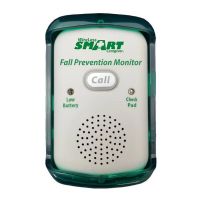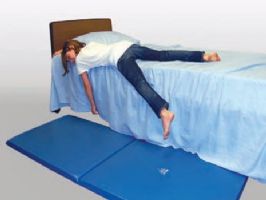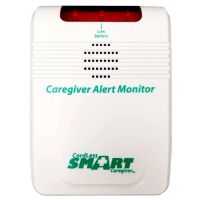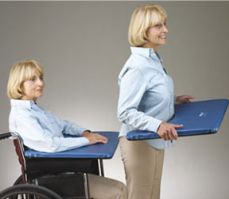 Written by Heather Collins, MSN, RN, CNOR
Written by Heather Collins, MSN, RN, CNOR
Bed alarms are essential tools for ensuring the safety and well-being of elderly patients. One out of five falls causes serious injury among older adults, and over 3 million elderly people are seen in emergency departments each year due to falls. Furthermore, falls in the elderly account for 40% of injury deaths. In light of these alarming statistics, finding effective safety devices to prevent injuries is vital.
When choosing a bed alarm for an elderly patient, it's important to consider key factors such as the type of alarm, volume, tone, range, durability, and ease of use. These considerations will help you make an informed decision and choose a bed alarm that meets the patient's specific needs and provides peace of mind for the patient and their caregivers. With so many options available, selecting the right bed alarm can be difficult, but by considering these key factors, you can confidently choose a bed alarm that is best suited for your patient.
Bed alarms are devices that are designed to alert caregivers or medical staff when a patient gets out of bed. These alarms can be used in hospitals, nursing homes, and other long-term care facilities, as well as at home, to prevent falls and ensure the safety of patients. They typically consist of a sensor placed under the mattress or on the bed frame and an alarm that sounds when the sensor detects movement. Additionally, some alarms can attach to the patient's clothes and alarms that detect motion. It is important to note that bed alarms are not meant to be used as a restraint but rather as a tool to alert caregivers to assist the patient and prevent falls. They can also be used in conjunction with other safety measures, such as bed rails and floor mats, to provide an added layer of protection.
Bed alarms, combined with other fall prevention strategies, can effectively reduce the incidence of falls. When implemented with environmental modifications, adequate lighting, and assistive devices, they are beneficial in helping people stay safe.
However, it is important to note that bed alarms alone may not prevent falls in all cases. Everyone has unique needs and preferences, and it is crucial to consider these when developing a fall prevention plan. Therefore, bed alarms should be used in conjunction with other fall prevention strategies to increase their effectiveness.
 | Smart Caregiver Wireless Bed Alarm with Pager View Product |
Recommended: Smart Caregiver Wireless Bed Alarm with Pager
Pressure sensor pads for bed alarms detect when a patient gets up from the bed and trigger an alarm. They are typically placed under the patient's back or shoulders and are hidden under the bed sheets. They are designed to take up minimal space and are often used in hospitals or other healthcare settings to monitor patients at risk for falls. These alarms alert the healthcare staff or caregiver that the patient has gotten out of bed. They are best suited for patients at risk of falling, such as those with dementia or other cognitive impairments. However, their effectiveness may be limited for highly mobile patients or who frequently roll around in bed, as it may trigger the alarm too often or even fail to detect when the patient has gotten out of bed.
 | Smart Caregiver Bed Alarm - CordLess® Alert Systems View Product |
Recommended: Smart Caregiver Bed Alarm - CordLess® Alert Systems
When patients leave the bed and their feet touch the floor, floor sensor pads detect this and sound an alarm. They are typically placed around the bed's perimeter and are intended to detect movement when the patient's feet make contact with the floor. These alarms notify caregivers or medical personnel that the patient has gotten out of bed. However, it should be noted that these alarms are only useful when the main concern is the patient getting completely out of bed. They may not detect if the patient is sitting on the edge of the bed or if they are getting in or out of bed in an unsafe manner. Therefore, it's important to consider the patient's unique needs and risk factors before using floor sensor pads.
 | Skil-Care Soft Fall Bedside Fall Mats and Alarm System View Product |
Recommended: Skil-Care Soft Fall Bedside Fall Mats and Alarm System
Motion sensor alarms are a type of fall prevention device that uses motion detection technology to alert caregivers or healthcare staff when a patient gets out of bed. These alarms are typically more high-tech than other bed alarms, such as pressure or floor sensor pads. They set up a field around the patient's bed, and an alarm sounds when the patient breaks the field by getting out of bed. However, motion sensor alarms can be more expensive than other bed alarms, and they may be more prone to false alarms. A false alarm can be triggered by the patient's arm hanging over the side of the bed or by other movements in the room. Therefore, it's important to consider the patient's unique needs and risk factors before using motion sensor alarms.
 | Smart Caregiver Patient Monitor System with Motion Sensor View Product |
Recommended: Smart Caregiver Patient Monitor System with Motion Sensor
String alarms are a type of fall prevention device designed to alert caregivers or healthcare staff when a patient gets out of bed. These alarms connect to the patient's clothing, typically a wristband or a pendant, and when the patient moves far enough away from the bed, the string is released, and an alarm sounds. However, string alarms pose a slight risk of strangulation if the string gets caught in something, and some patients may be able to figure out how to release the string without triggering the alarm, rendering them ineffective. Therefore, it's important to consider the patient's unique needs and risk factors before using string alarms. It's also important to ensure that the alarm is adjusted properly and that the patient wears it correctly to minimize the risk of strangulation.
 | SofTop Lift-Away Wheelchair Tray View Product |
Recommended: Personal Patient Safety Alarm for Slips and Falls
When purchasing a fall prevention device such as a bed alarm, it's important to consider the noise level of the device. If the device is too loud, it may disturb other people or patients and create an unnecessary commotion. Additionally, if the alarm is too soft, it may be difficult for staff members to hear in certain areas of the facility or home.
To mitigate this issue, it's worth ensuring that the volume or alarm style is adjustable or programmable only to trigger remotely. This allows you to set the volume at an appropriate level or to only trigger the alarm remotely, reducing the disruption of those around you. It also allows you to adjust the alarm to a level appropriate for the specific environment in which it will be used.
It's also worth considering the alarm style of the device. Some devices have a loud beeping alarm, while others have a more subtle alarm, such as a vibration or a flashing light. This can be useful if you want to reduce the noise level of the alarm but still want to be alerted when a patient gets out of bed.
Wired devices connect to an alarm unit or nurse call system through a physical cable or wire. They offer a reliable and consistent connection and are typically less expensive than wireless devices. However, they can be cumbersome and difficult to set up, and the wires can be a tripping hazard for patients. Additionally, the cables can be damaged, making the device inoperable. On the other hand, wireless devices use radio frequency technology to connect to an alarm unit or nurse call system without needing a physical connection. They are typically more expensive than wired devices but are easy to install and move around, making them more versatile. However, wireless devices may suffer from interference issues, and the battery life and signal strength may vary depending on the environment.
Bed alarms range in price from around $30 to over $500, so it's important to consider your budget when purchasing.
Call buttons and pagers are commonly used in healthcare settings where patients may require immediate assistance from staff members. The call button is typically a small device that the patient can press to request assistance, whereas the pager is a device that alerts the staff member that a call has been placed. The pager is especially useful for healthcare workers who are constantly moving. They enable the patient to signal for help quickly and easily without shouting or physically searching for a staff member. They can also be programmed to send alerts to specific staff members, ensuring that the appropriate person responds to the call. Call buttons and pagers are an integral part of a fall prevention strategy.
Setup complexity refers to the level of difficulty involved in setting up and using a device or system. Some devices, such as call buttons and pagers, may be incredibly simple to use and understand, with minimal setup required. Others, such as motion sensor alarms or wireless monitoring systems, might be more complicated and require a certain level of technical expertise to set up and operate effectively. It is important to consider the setup complexity when purchasing a device or system for a healthcare setting, as some systems may be better suited for clinics or hospitals with a dedicated IT staff, while others may be more appropriate for smaller facilities or home care settings.
It is also important to consider the user's ability to facilitate the mechanical operation of the device, as some devices may be more user-friendly and easier to operate for patients and staff, while others may require more technical knowledge. It is important to make sure that staff members can use and understand the device before purchasing it, to ensure that it can be used effectively
Fall prevention for the elderly is necessary, and bed alarms can be a game-changer. With so many options, it's important to tailor the choice to the patient's needs and risk factors. This way, you can give the patient and their caregivers the peace of mind they need.
Thank you for taking the time to read about bed alarms. Visit us at Caregiver University for more insightful information and expert advice on providing safe and effective care for the elderly.

Heather Collins, MSN, RN, CNOR
Heather is a registered nurse and freelance health writer with a Master's degree and over 24 years of nursing and leadership experience. Heather cares for patients of all ages in various healthcare settings, including inpatient acute care nursing, GI procedural nursing, cardiac lab, infertility clinics, pediatrics, and surgical services. Heather is dedicated to providing high-quality care and sharing reliable, evidence-based information that empowers people to make informed decisions about their and their loved ones' health.